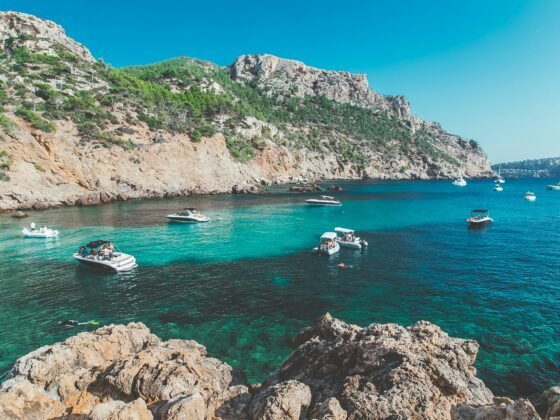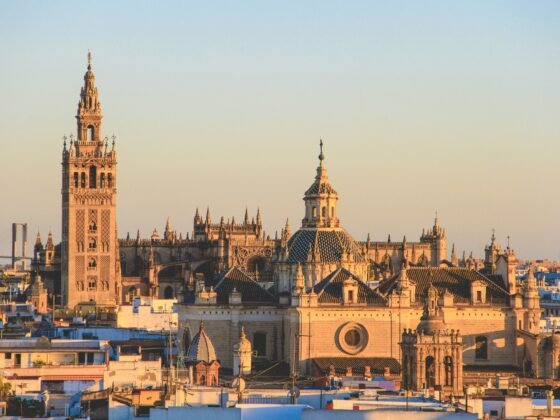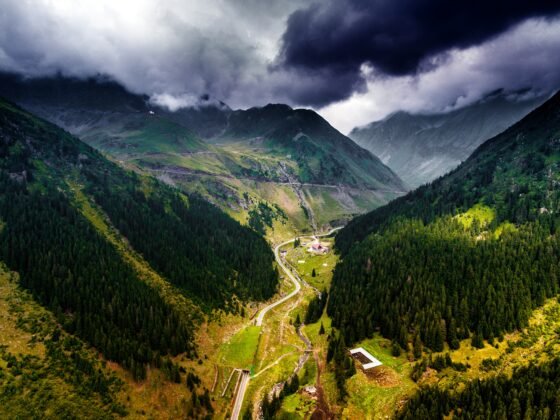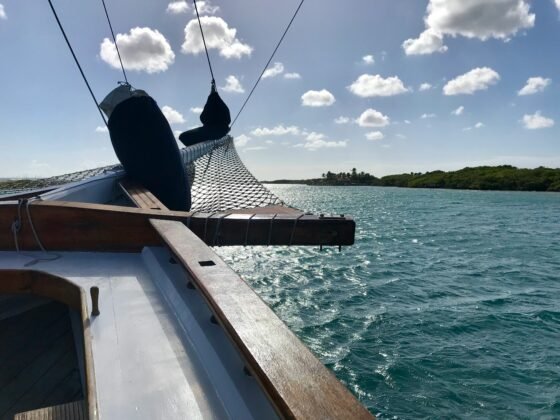Nestled along the North Norfolk coast, the picturesque village of Happisburgh (pronounced “Hays-bruh”) is a place where history, geology, and community converge. With its iconic red-and-white-striped lighthouse, crumbling cliffs, and archaeological significance, Happisburgh is not just a quintessential English village but a testament to resilience in the face of time and nature. So why is Happisburgh famous?
A Glimpse into the Past
Happisburgh’s recorded history dates back over a millennium, with its name appearing in the Domesday Book of 1086 as “Hapesburc.” The name likely derives from Old English, meaning “Hæp’s fort or stronghold,” indicative of its historical importance. The village’s connection to the past, however, extends far beyond its medieval roots.
For many years, the beach has been popular with fossil hunters looking for the remains of mammoth and other extinct species.

In March 2000, a local man walking his dog along Happisburgh’s beach made a remarkable discovery: a finely crafted black flint handaxe embedded in ancient sediments exposed by coastal erosion. This artefact, later dated to approximately 500,000 years old, provided the earliest evidence at that time of human occupation in Britain, predating previous findings by about 200,000 years. The handaxe’s craftsmanship suggests it was a versatile tool, likely used for tasks such as butchering animals and woodworking, offering valuable insights into the technological abilities and lifestyle of early humans in the region.
In 2013, Happisburgh gained international attention when archaeologists discovered the oldest known human footprints outside of Africa on its beaches. These prints, dating back around 850,000 years, offer a remarkable glimpse into the early inhabitants of Britain and their life during the Pleistocene epoch. The footprints are a rare and fragile link to our ancestors, preserved by layers of estuarine silt and revealed only fleetingly due to coastal erosion. The original footprints were destroyed by the sea after only a few weeks, but periodically new impressions are seen ” When I was shown the footprints by the British Museum, my first reaction was to tell then that we’d be seeing similar things for years, we just never know what they were,” said one Happisburgh resident. The impressions of animal tracks in the clays are not unusual.
The area is rich in archaeological finds, including flint tools and evidence of ancient settlements, which suggest that Happisburgh has been a focal point of human activity for hundreds of thousands of years. These discoveries make the village a critical site for understanding prehistoric life in northern Europe.
The Lighthouse: A Beacon Through Time
One of Happisburgh’s most recognisable landmarks is its lighthouse, the oldest working lighthouse in East Anglia and the only independently operated lighthouse in the UK. Built in 1790, the striped sentinel was originally one of a pair of lighthouses guiding mariners through the treacherous waters of the North Sea. Its twin, a lower light, was decommissioned in the late 19th century and eventually demolished.
The Happisburgh Lighthouse stands as a beacon of hope and community spirit. Threatened with closure in 1987, it was saved by the Happisburgh Lighthouse Trust, a group of dedicated locals who ensured its continued operation. Today, it remains fully functional, warning ships of the nearby sandbanks and attracting thousands of visitors each year.
For one resident who was born and brought up in the village, the lighthouse holds a special place in their memories. They recall climbing the lighthouse and being awed by the stunning view of the sea. A decade ago, they even participated in a zipwire event from the top of the lighthouse, raising funds for its upkeep—a perfect example of the community’s dedication to preserving this iconic landmark.
Coastal Erosion: A Community Under Siege
Happisburgh is perhaps most famously known for its dramatic and ongoing battle with coastal erosion. The village sits on soft glacial sediments that are highly susceptible to the relentless forces of the sea. Over the decades, numerous homes, farmlands, and roads have been lost to the encroaching waves. The rate of erosion is stark, with some estimates suggesting the coastline retreats by an average of two metres per year.

The village car park is at threat from coastal erosion as its access road is on the edge of the cliff. A new road is planned. Beach Road which, as the name suggests, runs from the village to the beach has borne the brunt of the erosion, with houses lost from its eastern end and holiday chalets that used to run along the cliffs now all taken by the sea. Efforts to combat erosion, such as the construction of new sea defences, have had limited success due to the governments policy of managed retreat. However, the community continues to adapt and fight for its future.
For one local, the beach becomes an atmospheric place after a winter storm. The ancient sediments are exposed, and the cliffs slowly fall onto the beach, revealing layers of history that serve as a stark reminder of nature’s power.
The erosion also exposes ancient layers of sediment, revealing fossils and artefacts that add to Happisburgh’s historical significance. For some, the erosion is both a curse and a gift, as it lays bare treasures of the past while threatening the present.
Natural Beauty and Wildlife
Despite its challenges, Happisburgh boasts stunning natural beauty. The village is surrounded by rolling fields, and its unspoiled beaches are a haven for walkers and nature enthusiasts. The dramatic cliffs, though precarious, provide nesting sites for birds such as Sand Martins, and the intertidal zone is teeming with marine life such as both grey and common seals.
Happisburgh is also a part of the Norfolk Coast Area of Outstanding Natural Beauty, a designation that highlights its ecological and scenic importance. The local environment supports a variety of flora and fauna, from wildflowers that bloom along the cliffs.
The Village Today
Happisburgh is a small but vibrant community. It is home to a primary school, a parish church, a local shop, and a pub, all of which serve as hubs for residents and visitors alike. The village has a strong sense of identity and a determination to preserve its heritage and way of life despite the challenges it faces.
The Church of St. Mary’s, a Grade I listed building, dominates the village skyline alongside the lighthouse. This medieval church, with its impressive tower, is a testament to Happisburgh’s historical and architectural significance. Inside, visitors can find stunning stained-glass windows, intricate woodwork, and a sense of timeless serenity.
Happisburgh has a RNLI lifeboat station situated at Cart Gap just south of the village. The original station on Beach Road in the village was destroyed by coastal erosion in 2002.
Happisburgh’s Role in Climate Change Awareness
Happisburgh’s plight has made it a focal point in discussions about climate change and its impact on coastal communities. As sea levels rise and extreme weather events become more frequent, the village’s experience serves as a poignant example of the challenges faced by vulnerable coastal regions worldwide.
One resident has actively contributed to this discussion through art. They curated “The Extinction Collection,” a series of sculptures featuring fossils from Happisburgh’s cliffs. This powerful exhibition highlights how historic climate change led to the extinction of many species, drawing parallels to the modern-day climate crisis. The Extinction Collection was created by the charity Explorers Against Extinction to provoke thought and action on climate issues. Through the use of ancient materials such as the Happisburgh handaxe and fossils, alongside works by leading sculptors and artists, the collection bridges the past and present, urging viewers to consider the long-term impacts of climate change on both humanity and biodiversity.
Efforts to raise awareness about Happisburgh’s situation have included art installations, media coverage, and academic studies. The village’s story is a powerful reminder of the need for sustainable environmental practices and proactive climate policies.
Happisburgh in Art and Culture
The unique landscape and poignant history of Happisburgh have inspired countless artists, writers, and photographers. Its lighthouse and crumbling cliffs have become iconic symbols of resilience and beauty in the face of adversity. Notably, artists such as JMW Turner, Barbara Hepworth and Henry Moore were drawn to the dramatic scenery of Norfolk, including Happisburgh.
Why is Happisburgh famous? Well, more recently, modern painters and photographers have stayed in the village to capture its light, textures, and evocative landscapes. Art exhibitions, such as those featuring works created with materials from the Happisburgh coastline, highlight the intersection of nature, history, and creativity. As mentioned above, The Extinction Collection, curated by the charity Explorers Against Extinction which is based near Happisburgh, features sculptures containing fossils and early flint axes from Happisburgh and includes works by Turner Prize winning Richard Deacon, David Nash, Andy Goldsworthy, Conrad Shawcross, Julian Stair, Eleanor Lakelin, Emily Young and Michael Pinsky. This Collection has been exhibited across the UK – making Happisburgh famous across the country.

Historic Smuggling in Happisburgh
In the 18th and early 19th centuries, Happisburgh’s remote coastal location made it a haven for smuggling activities. The village’s secluded beaches and treacherous sand banks provided ideal conditions for smugglers to clandestinely land contraband goods such as brandy, tobacco, and silk. Local folklore tells of mysterious lights being seen offshore, signalling to unknown people.
One of Happisburgh’s most enduring legends is that of the “Pump Hill Ghost,” a spectral figure believed to be the restless spirit of a murdered smuggler. According to accounts from the late 17th or early 18th century, villagers reported sightings of a headless and legless apparition dressed in sailor’s attire, carrying a bundle in its arms. The ghost was often seen gliding up the main street from the direction of Cart Gap, its head hanging down its back, suspended by a strip of flesh. Brave locals who followed the specter observed it dropping the bundle into a well at Pump Hill—formerly known as Well Corner—before vanishing. Upon investigating the well, villagers discovered a sack containing severed legs and, subsequently, the torso of a man dressed as a sailor. This gruesome find led to speculation that the smuggler had been killed by his accomplices over a dispute and his body concealed in the well.
Adding to the village’s rich smuggling history, The Swan Inn on Whimpwell Street—known as The White Swan in 1794—was reputedly used as a holding place for captured smugglers. The inn, which closed in 1970 and has since been converted into a private residence, is believed to have served as a temporary prison where apprehended smugglers awaited transport to larger facilities. Evidence of an attempted prison break is still visiblei n the beam mantle over the fireplace when a musket was shot to frighten off smugglers trying to free a friend, caught bt the army. It was unsuccessful – he was taken to Norwich Castle and hanged.
These tales of clandestine operations and spectral apparitions contribute to Happisburgh’s rich tapestry of history and folklore, offering intriguing glimpses into the village’s past.
Looking Ahead
Happisburgh’s future is uncertain, as coastal erosion continues to pose significant challenges. However, the resilience and ingenuity of its community offer hope. Initiatives to document and preserve its heritage, coupled with efforts to adapt to environmental changes, demonstrate the strength of this remarkable village.
For one lifelong resident, Happisburgh is not just a place but an example for the world. They believe the village’s history—as the site of the oldest known human occupation in the UK—and its ongoing struggles with modern-day climate change should serve as a powerful lesson in how communities can adapt and survive.
As a place where the past meets the present, and where natural beauty coexists with stark realities, Happisburgh stands as a symbol of the delicate balance between humanity and nature. It is a village worth visiting, studying, and cherishing for generations to come.
Visiting Happisburgh
For those seeking to experience Happisburgh first hand, the village offers a range of attractions and activities. The lighthouse is open to the public on select days, allowing visitors to climb to the top for breath-taking views of the Norfolk coast. Guided walks and tours delve into the village’s rich history and ongoing geological changes.
The beaches, while subject to erosion, remain a popular destination for fossil hunting and exploring. Visitors are reminded to tread carefully and respect the natural and archaeological significance of the area. You can see the Time & Tide Bell, installed on the beach in 2023 as part of a series across the UK making places where many sailors have been lost to the sea.
Happisburgh’s local events, such as village fairs and lighthouse open days, provide opportunities to engage with the community and learn more about its unique story. The village’s welcoming atmosphere ensures that every visitor leaves with a sense of connection to this extraordinary place. The annual Lifeboat day is held on the first Sunday in August and the Church fete is usually on the last bank holiday in August.
Where to Stay
Goldfinch Cottage
– A comfortable, spacious self-catering cottage located just one mile from Happisburgh beach. This dog-friendly accommodation offers a tranquil rural setting, making it an ideal retreat for those looking to unwind.
– https://goldfinchnorfolk.co.uk/
Lighthouse Cottage
– Built in 1791, this Grade II listed former lighthouse keeper’s cottage adjoins Happisburgh’s working lighthouse. It offers well-equipped, comfortable holiday accommodation with extensive sea and inland views, providing a unique coastal experience.
– https://www.cottages.com/cottages/lighthouse-cottage-cwd
White Cottage
– Nestled on the edge of Happisburgh, this over 200-year-old cottage has been updated to provide utmost comfort for guests and their dogs. With views of the iconic Happisburgh Lighthouse and proximity to the beach, it serves as a perfect base to explore Norfolk.
– https://www.whitecottagenorfolk.co.uk/
Where to Eat
Smallsticks Café
– Situated at Cart Gap, Smallsticks Café is a family-run establishment offering a selection of cakes, coffees, lunches, and dinners. It’s an ideal stop after a beach walk, providing a welcoming atmosphere and a variety of menu options.
The Hill House Inn
– A historic pub dating back to 1550, The Hill House Inn offers a cosy atmosphere with period features, including a central bar, dining room, and a large beer garden. The kitchen serves home-cooked pub cuisine using seasonal, locally sourced produce and meats.
The Star Inn & Restaurant
– Located in the nearby village of Lessingham, The Star Inn is a traditional pub known for its warm and friendly service. It offers freshly prepared, high-quality food with generous portions, featuring a menu that includes British cuisine and vegetarian-friendly options.
These establishments provide a glimpse into the hospitality and culinary delights that Happisburgh and its surroundings have to offer, ensuring a memorable visit to this historic coastal village.
FAQ
Why is Happisburgh famous?
Happisburgh, a village in Norfolk, England, is famous for its significant archaeological and geological discoveries. It is home to the oldest known human footprints in Europe, estimated to be around 850,000 years old, as well as early prehistoric tools and remains that provide evidence of ancient human habitation in Britain. Additionally, Happisburgh is known for its striking coastal erosion and the iconic red-and-white striped lighthouse.
How do you pronounce Happisburgh in Norfolk?
Happisburgh is pronounced “Hays-bruh” or “Haze-bruh”, despite its spelling.
What happened at Happisburgh?
People often ask Why is Happisburgh famous? One reason is that Happisburgh has experienced significant coastal erosion, leading to the loss of homes and farmland to the encroaching sea. The coastline’s rapid erosion is caused by the soft clay and sand that form its cliffs, which are highly vulnerable to wave action. The discovery of ancient human footprints and tools has brought global attention to the area, highlighting its importance in understanding early human history.
Are the Happisburgh footprints still there?
No, the Happisburgh footprints are no longer visible. They were discovered in 2013 in sediment layers exposed by tidal action. The fragile prints, believed to have been made around 850,000 years ago, were quickly eroded away by the sea after their discovery. However, they were carefully documented and studied by archaeologists before disappearing. They are one reason why Happisburgh is famous.
Why is Happisburgh not protected?
Happisburgh is not fully protected from coastal erosion due to cost-benefit analyses and funding constraints. The area has not been prioritized for large-scale sea defense projects because of its relatively small population and limited economic value compared to other parts of the Norfolk coastline. This has left the village vulnerable to the effects of erosion.
How old are the Happisburgh footprints?
The Happisburgh footprints are estimated to be approximately 850,000 to 950,000 years old, making them the oldest known human footprints outside Africa. They provide valuable insights into early human migration and life in prehistoric Europe.












